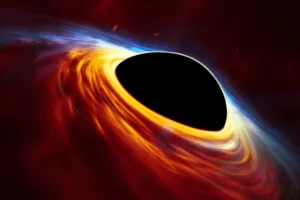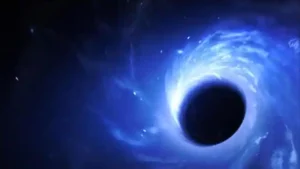A black hole that is both inactive and looks to have formed without the explosion of a dead star has been discovered in a galaxy near our Milky Way, which astronomers are referring to as a cosmic ‘needle in a haystack’.
According to researchers, this black hole is unique from all others in that it is ‘X-ray quiet’ that is, it does not emit strong X-ray radiation that would indicate it is suckling up the nearby matter with its powerful gravitational pull, and that it was not created in a stellar explosion known as a supernova.
Black holes are extremely dense objects with extremely strong gravity that prevents even light from escaping. This entity, which is roughly 160,000 light years away from Earth and has a mass at least nine times that of the sun, was discovered in the Tarantula Nebula region of the Large Magellanic Cloud galaxy. 5.9 trillion miles is the distance that light travels in a year, or a light year (9.5 trillion km).

This black hole is orbited by a very bright and blazing blue star that is about 25 times as massive as the sun. The name of this purported binary system is VFTS 243. According to the researchers, the companion star may someday also develop into a black hole and combine with the primary one. Thought to be rather frequent, dormant black holes are difficult to find since they seldom interact with their surroundings. With more research, many previously presented options have been refuted, including by the team that found this one.
Finding those objects is difficult, according to Tomer Shenar, the main author of the study published in the journal Nature Astronomy and a research fellow in astronomy at Amsterdam University. Astronomer and research co-author Kareem El-Badry of the Harvard & Smithsonian Center for Astrophysics said that it was the first object of its sort to be found after decades of investigation.

The Very Large Telescope of the European Southern Observatory, located in Chile, was utilized by the researchers. Black holes fall into a variety of categories. The smallest black holes, including the most recent ones, are known as stellar-mass black holes, which are created when huge individual stars collide at the end of their lives. Along with the large supermassive black holes that are found in the center of most galaxies, there are also intermediate-mass black holes.
Only if there is anything around that they can consume, can black holes be ruthlessly voracious. Julia Bodensteiner, a postdoctoral research fellow at the European Southern Observatory in Munich and study co-author, noted that in most cases, we only notice them if they are accreting material from a companion star. In so-called inactive black hole systems, the companion is far enough away that material does not build up around the black hole to heat up and generate X-rays, Shenar continued. Instead, the black hole rapidly eats it up.


